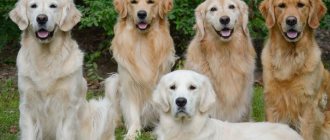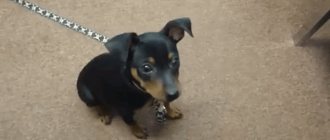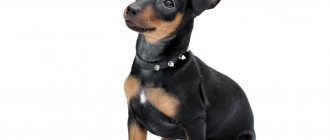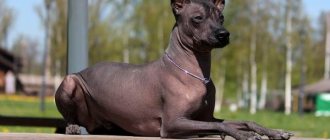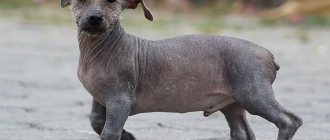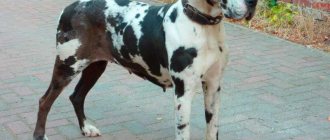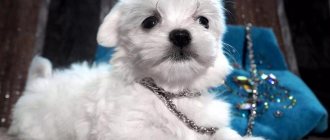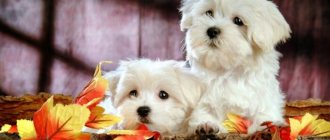They are popular among exotic lovers. Outwardly they are somewhat similar to each other, but there are differences in appearance, character, behavior and habits. For most, the history of the breed goes back thousands of years. Some of them are selectively bred.
Hairless dogs are almost hairless. One of the common myths about hairless dogs is that they do not cause allergies, do not smell specific, and are easy to train. This is more of a layman's view. It is important to consider that it was the breeders who ensured that there was almost no hair.
These are ideal dogs for hot countries, where the “bald” climate makes it easy to tolerate persistent high temperatures. In the last two decades, the demand for such dogs has increased, and the price of offspring increases every year. There is one “slowing down” factor: many dogs are not recognized internationally. This is a matter for the future.
History of the origin of the Xoloitzcuintle
Xoloitzcuintle - description and characteristics of the breed
Xoloitzcuintle is an ancient breed formed as a result of a genetic mutation. Hairless (hairless) dogs turned out to be ideally adapted to the Mexican climate and were less likely to suffer from blood-sucking parasites.
Thanks to their extraordinary appearance, they interested the Aztecs and received the name “Xoloitzcuintli” in honor of the god of the underworld, Xolotl (Xolotl), who controlled thunderstorms and accompanied the sun.
Because of their frightening appearance, hairless dogs were considered faithful companions of God and the dead on their way to the other world.
The Aztecs believed that human souls encountered a number of obstacles that could only be overcome with the participation of a four-legged assistant. The key role of the Xoloitzcuintle is confirmed by clay figurines and mummies of dogs found during archaeological excavations. The most ancient of them date back to the 5th millennium BC. e.
The Aztecs had a ritual that involved the ceremonial killing of a dog that belonged to a deceased warrior. They put the owner's arrow into the dog's mouth and buried the bodies, sometimes mummifying them first.
Archaeologists conducting excavations in Mexico and the territory of the modern United States have found dozens of similar burials.
Some finds suggest that Xoloitzcuintles were bred for the purpose of subsequent consumption as food. Their meat was considered a delicacy and was prepared only on the occasion of important religious holidays.
The Aztecs believed that fine dining honored deities and endowed ordinary people with the gift of prophecy. They also considered the meat of hairless dogs to be a powerful aphrodisiac that increases male strength.
With the advent of the conquistadors, the culture of the descendants of the Aztecs began to be persecuted. The conquerors demanded that the aborigines renounce ancient rituals and begin to massively destroy their dogs. By the end of the 16th century, the Xoloitzcuintle could only be found in remote mountain villages in Mexico.
In the first half of the 19th century, the skins of hairless dogs began to be used for the production of leather products. In 1850, art lovers noticed unusual animals and achieved an end to their ruthless exploitation. Enthusiastic dog handlers formed groups and traveled to remote mountain villages in search of hairless dogs.
If you speak English, we advise you to look at the article about this breed on the English-language Wikipedia site, there are many quite interesting links at the end.
In 1887, Xolos received recognition from the American Kennel Club, but quickly lost popularity and were removed from the AKC breed registry. The breed owes its revival to Norman Pelham Wright, who in 1954 bought more than a dozen hairless dogs from the Indians. The naturalist took up breeding work seriously and described the animals in detail in his work “The Mystery of the Xolo.” Thanks to his efforts, the breed was officially recognized in Mexico in 1956, and in 2011 it was re-included in the AKC registry.
About how I got a dog and found my best friend!
1. Background
I really wanted to have an animal that would run and jump everywhere, and not sit in a cage. My husband was very against both dogs and cats (no one wants to go for a walk in the morning, and it’s not comfortable in a one-room apartment with a dog), and besides, I’m allergic to cats (to wool) .
Without hesitation, I decided to get a naked cat at my grandfather’s dacha, I thought at least there would be someone running around the house. In principle, I didn’t choose Canadian or Donskaya.... I looked through Avito for a long time (I didn’t need an animal from a breeder and I didn’t have a lot of finances). Finally found it! I followed her to the region across Moscow during rush hour on the weekend.
As soon as I saw this little bundle with a Boyarsky mustache , I fell in love immediately (although when I was traveling, I wanted a completely different kitten in color). We called him Fenya, but now we just call him Kotik. =)
Description of the breed
Xoloitzcuintle - description and characteristics of the breed
To better understand the characteristics of the Mexican hairless Xoloitzcuintle dog, you can look at the table compiled based on the opinion of experts and reviews of the owners.
| Criterion | Rating (0 to 5) |
| Aggressiveness | 1 |
| Activity | 3 |
| Training | 3 |
| Need for care | 4 |
| Friendliness | 3 |
| Attitude towards loneliness | 1 |
| Health | 5 |
The data in the table are averages and do not always coincide with the characteristics of an individual Xoloitzcuintle, since it is impossible to take into account all the individual characteristics of a particular dog.
Appearance of the Sphinx blenny
An elongated body ending in a rounded caudal fin. The supraorbital tentacles of the sphinx blenny are well developed, thread-like, somewhat flattened, almost equal in length to the diameter of the eyes, sometimes exceeding it. At the posterior edge of the low tube of the anterior nostril there is a short blade, fringed at the end. The interorbital space is concave.
The dorsal fin has a deep notch between the unsegmented and articulated rays, and is not connected to the caudal fin. The first two rays of the anal fin in large males are covered with non-cluster-like growths. The pectoral fins in large ones extend to or beyond the beginning of the anal fin, in juveniles they extend beyond it. The groove above the upper lip is well developed.
Related article Peacock blenny (Salaria pavo)
The head in front of the eyes descends steeply to the end of the snout. 32-37 teeth on the upper jaw, 27-35 on the lower jaw, both outer ones are enlarged in the form of fangs, larger on the lower jaw. The lateral line has a sharp downward bend above the end of the pectoral fin, its canal in front is continuous until the bend, at the very beginning with several branches directed backwards, at the bend in the form of separate segments opening with pores in front and behind; further unclear. Infraorbital canal with transverse branches extending downward, opening with a large number of pores.
Appearance of the Xoloitzcuintle
Appearance of the Xoloitzcuintle
According to the international classification, the Xoloitzcuintle belongs to group 5 “Spitz and primitive dogs”, subgroup 6 “Primitive dogs” without testing working qualities. The exterior requirements for typical representatives of the breed are specified in detail in the FCI standard No. 234.
| Head | Wedge-shaped, wide in the skull, gradually tapering to a straight muzzle. The occipital protuberance is moderately pronounced. The stop is light and clearly defined. Cheekbones are poorly developed. The jaws are strong, square, covered with tight-fitting, dry lips without jowls or drooping lips. Scissor bite or straight bite. The teeth are fully complete, but in the bare variety the absence of several units is acceptable. |
| Eyes | Medium size, almond-shaped with a wary, intelligent look. The shade of the iris depends on the color and can be yellow, amber, hazel, brown or black. |
| Ears | Long, large, set high. When alert, they are kept at an angle of 50-80 degrees relative to the horizon. |
| Neck | Proportionally long, set high, dry, flexible, slightly curved. With developed muscles and elastic, tight-fitting skin. |
| Frame | Strongly built with a short, strong back, muscular loin and slightly convex croup. The chest is deep, fairly wide with slightly convex ribs. The belly is moderately tucked. |
| Limbs | Smooth, muscular with “hare” paws, curved toes, developed membranes and strong pads. The movements are long, free, elegant. |
| Tail | Long, thin. When straightened, it reaches the hock joints. When moving, it bends upward without lying on its back. |
| Wool | The hairless variety is covered in warm, smooth sensitive skin. The presence of hard hairs is permissible on the head, back of the neck, limbs and tip of the tail. The wool variety is evenly covered with short, smooth hair without undercoat. |
| Color | Black, fawn, bronze, liver, red, graphite, dark or light gray. Spots of any shade are acceptable. |
| Possible defects | Wide head, wrinkled raw skin, excessive dewlap, sloping croup, splayed paws, meek/tightly curled/slung hosta, round/light/bulging eyes. |
| Disqualifying faults | Blindness, deafness, malocclusion, cropped/droopy ears, paralyzed tongue, blue/multi-colored eyes, cryptorchidism (in males), height below 25 cm or above 62 cm, albinism, abnormal color and hairless dogs . |
African hairless dog
The second name is Abyssinian sand terrier . One of the rarest breeds (about 400 individuals worldwide), it is very difficult to find representatives in Russia. Therefore, practically nothing is known about dogs.
Like all hairless dogs, Terriers were considered sacred and were used in ritual ceremonies. Almost nothing is known about the history of animals. Approximate place of origin: Africa. There is an opinion that the animals became the basis for the breeding of Chinese crested cats . The breeds are similar in size, build, and color. Abyssinians also have hair on their head and tail.
An interesting fact is that dogs cannot bark, but they can learn to do so by hearing the “conversation” of their relatives.
Regardless of whether the voice has emerged or not, Abyssinian Terriers are very brave and courageous, ready to protect their owner, despite their modest size (up to 25 cm at the withers). Animals do an excellent job of protecting property, but raising and training them is difficult, so natural habits and instincts often take over.
African Hairless cats are gentle and attentive, love their family, and treat children of all ages well. Dogs understand their owners on a moral level, support and reassure.
Character of the Xoloitzcuintle
Xoloitzcuintles are friendly, balanced and moderately energetic dogs that quickly get used to people. They treat all household members with equal respect, but they single out one among them, whom they consider their master. As puppies, Xoloitzcuintles can be overly playful, but with age they calm down and become quieter and more attentive.
Important! Among Xoloitzcuintles, there are often overly emotional individuals who react sharply to sudden changes in schedule, change of environment and loud sounds.
Although dogs of this breed are quite patient, they will not ignore disrespectful treatment. Therefore, it is better not to get a Xoloitzcuintle for those who have young children. But with teenagers they can easily find a common language and be able to make friends.
Xoloitzcuintles get along well with other pets, especially if they grew up with them. They are not so loyal to other people's dogs and will never miss an opportunity to prove their superiority.
Xoloitzcuintles are wary of strangers and do not like to be in the company of strangers. Their developed sense of smell and hearing help them sense the approach of a stranger in advance and warn their owners with a quiet bark.
Chinese Hairless Crested Dog
The most popular hairless dog, brought to Europe at the end of the 19th century from China. The animals cannot be called completely bald: they are characterized by the presence of a white crest, feathering on the ears and a tassel on the tail. As for the rest of the body, they are covered with thin elastic pinkish skin with bright brown pigment spots.
These dogs are not working dogs. Since ancient times, since the times of the Chinese Empire, they have been valued as sacred. And in European society, the breed became a symbol of eccentricity, so its first breeders were stars with an unusual image or lifestyle.
The dogs have a graceful figure: long thin limbs, a curved back with a smooth neck, and a lean belly. They are dexterous, fast, and capable of learning. In the Crested family, they are kind, flexible, and loving. They get along well with children and other pets, but require attention. Without care, such pets become sad and find it difficult for them to be without their owner for a long time.
In Russia, a puppy can be purchased for 10-20 thousand rubles. The price will depend not only on class and pedigree, but also on appearance. Downy Chinese Cresteds, completely covered with wool, will cost a little more.
Education and training
Xoloitzcuintli has a rather capricious and stubborn character, which greatly complicates the process of her training. In order for an obedient dog to grow from a touching puppy, you need to raise the animal from the first days of its appearance in the house.
It is important to remember that harsh training methods are not applicable to the Xoloitzcuintle. Gentle but persistent treatment will be more effective than shouting and spanking.
Xoloitzcuintles are breeds that require early socialization. If you miss this moment, the dog will grow up fearful or aggressive.
In order for the puppy to gain the necessary experience and learn to calmly deal with stimuli, he is often walked in different busy places where there is transport, cyclists, strangers and animals.
Ecuadorian hairless dog
The place of origin of the breed is Guatemala, it is believed that it appeared by mixing the blood of Peruvian orchids and Mexican naked ones. These dogs are difficult to find even in their historical homeland. They are not sold, they are not specially bred, there is not a single kennel that would offer to purchase an Ecuadorian Hairless puppy.
Animals are bred in Ecuadorian and African villages, in uncivilized forest tribes. Dogs help people around the house, hunt rodents and entertain children. Priests are confident in the ability of pets to drive out evil spirits and heal body and soul.
It is believed that this breed is the smartest among hairless ones, although there is no confirmation of this opinion.
Overall, Ecuadorians make excellent companions. They are cheerful, friendly, active, but willful and freedom-loving, like all aboriginal dogs.
Features of feeding and diet
Xoloitzcuintles are prone to allergies and require a carefully considered diet. The basis of their diet should be lean meat with veins and cartilage. It is better if it is beef, veal, lamb, rabbit or turkey. It is not advisable to feed chicken to Xoloitzcuintle due to the risk of developing allergies.
You can also supplement your dog’s diet with:
- cereals (rice, buckwheat, oatmeal);
- eggs;
- vegetables (pumpkin, carrots, zucchini);
- low-fat fermented milk products (cottage cheese, kefir, fermented baked milk).
With a natural type of diet, Xoloitzcuintles should not be fed with fatty and fried foods, pickles, sweets, smoked meats, exotic fruits, baked goods and sausages.
Toothless dogs or animals that are missing more than 5-6 teeth are recommended to be fed food ground to a mushy state, or high-quality industrial canned food.
We recommend reading:
American Akita: characteristics and description of the breed
Staffordshire Terrier breed characteristics, character, education, maintenance and care
Video
* We invite you to watch a video about the Xoloitzcuintle . In fact, in front of you is a playlist in which you can select and watch any of 20 videos about a given dog breed by simply clicking on the button in the upper right corner of the window. In addition, the material contains quite a lot of photos. By looking at them you can find out what a Xoloitzcuintli looks like.
- History of the origin of the Xoloitzcuintle
- Xoloitzcuintle - description of the breed
- Popular Xoloitzcuintle colors
- Character and habits of the Xoloitzcuintle
- Interesting facts about the Xoloitzcuintle
- Pros and cons of the Xoloitzcuintle
- Breeding Xoloitzcuintle
- Caring for the Xoloitzcuintle
- Xoloitzcuintle diet
- Diseases and health problems
- Xoloitzcuintle - price and how to buy correctly
Tips for choosing a puppy
The Xoloitzcuintle is a rare breed, with a small number of nurseries specializing in its breeding.
Since puppies bear little resemblance to their parents, it is better to buy them not “from hand”, but from a trusted breeder.
At the time of sale, babies must have documents confirming their breed and the presence of preventive vaccinations.
When choosing a puppy, it is advisable to pay attention to the following points:
- Conditions of detention. Mother and puppies should be kept in a clean, bright and well-ventilated area. It is important that there are no drafts, otherwise there is a risk of buying an animal with a cold.
- Peculiarities of behavior of puppies. Kids should be active, playful and curious. It is important that they are not afraid to approach strangers and do not show aggression.
- Appearance. Xoloitzcuintle puppies are not at all similar to adult representatives of the breed. The babies have a blunt muzzle, awkward short legs and a plump body covered with folded skin.
Miniature, medium and standard puppies can be born in one litter, and it is extremely difficult to predict how a particular baby will grow up.
Price
There are very few Xoloitzcuintles in Russia. There is only 1 nursery in the capital where they are bred and sold. By making a purchase in this place, you get a guarantee of purchasing a hairless Mexican dog that fully complies with the standard of its breed. But buying it second hand is not worth it.
The price of a xoloitzcuintle in 2022 is 80 thousand rubles. There are a lot of advertisements on the Internet for the sale of non-purebred representatives of this breed, which are sold much cheaper, from 10 to 30 thousand rubles. But, most of the animals offered there have nothing in common with the Mexican Hairless.
Peruvian Inca Orchid
“Peruvians” are graceful and elegant, harmoniously built, and the texture of their skin is similar to that of humans. There are two types: naked and “woolen”. In hairless animals, remnants of vegetation can be found on the head, tail and legs. The skin is smooth and elastic, ideally uniform. The presence of white or pink spots is allowed, the area of which should not exceed a third of the total surface of the skin.
Among the woolly “Peruvians” there are three types: short-haired, smooth-haired and long-haired. The latter are extremely rare. The most prized among them are the short-haired smooth Inca orchids.
